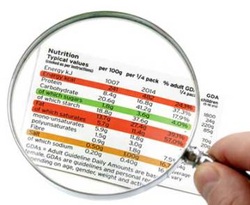 Decipher Your Food Labels – Jenelle Croatto APD Choosing what food to eat use to be as simple as selecting from the food that was available to you. This often meant sourcing local, seasonal food that was minimally processed. Today with a global food market and an ever expanding selection of packaged goods it is no wonder that we question what food we should be putting into our shopping trolleys. The easiest way to select healthy nutritious food is that which comes without the fancy packaging – think fresh animal and plant foods. However, with our busy lifestyles it is very convenient, and often economically sound, that a portion of our regular food shopping be of the packaged type. Having an understanding of food labels will help you be ‘aislewise’ and supermarket savvy. 1. Check the ingredients list All ingredients are listed in order of decreasing weight. This is an easy way to gauge what the bulk of your product is comprised of. Look at the first three ingredients to see if the product is high in saturated fat, sodium (salt) or added sugar. 2. Serving size & per 100g column Keep in mind that the specified serve size on the product may not be the amount you actually consume. Therefore, it is best the use the per 100g column to determine whether a particular product is your best choice. This column is also useful to compare nutrients between similar food products 3. Total Fat General rule of thumb - choose foods with less than 10g per 100g Dairy products choose less than 2g per 100g – cheese is the exception which should have no more than 15g per 100g Other names for fat include – palm oil, lard, ghee, copha, cream, milk solids, coconut oil/milk/cream, dripping, beef fat, animal fat/oil and butter. 4. Saturated Fat Choose foods which have the lowest amount, per 100g Ideally, less than 3g per 100g 5. Sodium (salt) Foods with less than 120mg per 100g are classified as a low salt product. If this can’t be found a good cut off mark is less than 400mg per 100g Other names for high salt ingredients include – rock salt, celery salt, baking powder, meat/yeast extract, onion salt, sodium, monosodium glutamate (MSG), sodium ascorbate, sodium bicarbonate, sodium nitrate/nitrite, stock cubes and vegetable salt 6. Sugars Avoid large amounts of added sugar by selecting foods that contain no than 15g per 100g When looking at cereals with dried fruit opt for one that is less than 25g per 100g Other names for sugar include – glucose, fructose, dextrose, honey, sucrose, malt, maltose, lactose, brown sugar, caster sugar, maple syrup and golden syrup. 7. Fibre Opt for a product that has at least 3g fibre per serve 8. Allergens Foods that are known common allergens (such as peanuts, seafood, gluten, eggs and soybeans) must be declared on the food label. Discretionary statements such as ‘may contain nuts’ are useful as often many products are manufactured in the same premises as various allergenic foods. In time you will become familiar with the regular products you purchase and will not need to be constantly checking food labels. This however is not the case for those people with food allergies. I recommend regularly checking the labels of all the products you purchase as ingredient list will often change and could potentially contain the allergen you need to avoid.
0 Comments
Your comment will be posted after it is approved.
Leave a Reply. |
News FEEDFitness, Energy, Education & Diet Archives
June 2020
Categories
All
|
 RSS Feed
RSS Feed